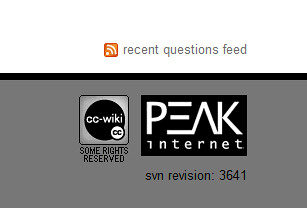A few months ago when I stared using stackoverflow I noticed that they output the current Subversion revision number into their html source.

This is both cool and useful and as I’m about to become a SVN Nazi and make sure that all new projects at work are placed under source control (only a few are at present) I wanted to know how to do it.
Getting the tools
Most of our projects are built using ASP.NET so I wanted to know how to get this working from within Visual Studio. Thankfully this didn’t take long, a few Google’s turned up MSBuild Community Tasks Project hosted over at Tigris.org who are the good folks behind Subversion and many many Subversion tools. I had a quick look over the list of tasks and spotted the “SvnVersion” task and thought that sounds about right. I downloaded and installed the Community Tasks.
I also downloaded the Visual Studio Web Deployment projects after having read ScottGu’s blog post regarding them. You can get the VS2008 version here or the VS2005 version here if you need it.
Getting the revision into your HTML
To get the revision number into my HTML I chose to add a Web Deployment project (right click on your website/web app in the solution explorer and “Add web deployment project” then right click on this new project and “Open project file”. What you’ll see now is the XML of the MSBuild file and towards the bottom of this file should be a comment with four target tags in it like this.
<!-- To modify your build process, add your task inside one of the targets below and uncomment it.
Other similar extension points exist, see Microsoft.WebDeployment.targets.
<Target Name="BeforeBuild">
</Target>
<Target Name="BeforeMerge">
</Target>
<Target Name="AfterMerge">
</Target>
<Target Name="AfterBuild">
</Target>
-->We’re going to use the AfterBuild target so to place the revision number in a little bit of HTML that’s going to live in a master page, so let’s set up the master page first.
My site is a .NET MVC application and I’m going to add the revision number to the Site.Master. To do this I added the following HTML to the footer of the master page.
<span id=”rev”>revision REVISION</span>
The SvnRevision task will get the revision number from our working copy and store it in a property name that we define.
We can then use another Community Task, FileUpdate, to update the master page after the build.
Here is the XML of the AfterBuild target looks, note also that before the target I have imported the Community Tasks that we downloaded and installed earlier.
<!-- Import the community build tasks-->
<Import Project="$(MSBuildExtensionsPath)\MSBuildCommunityTasks\MSBuild.Community.Tasks.Targets" />
<target name="AfterBuild">
<! -- Add the SvnVersion build task -->
<svnversion toolpath="$(ProgramFiles)\VisualSVN\bin" localpath="$(MSBuildProjectDirectory)">
<output propertyname="Revision" taskparameter="Revision" />
</svnversion>
<fileupdate replacementtext="revision $(Revision)" regex="revision REVISION" files="$(Configuration)\Views\Shared\Site.Master" />
</target>
The FileUpdate finds the string defined in the regex attribute and replaces it with the string in the replacementText attribute. $(Revision) is MSBuild syntax for a property (like a variable in other languages) where “Revision” is the property name. The files attribute tells the fileUpdate action which file to work with when doing this replacemnet. In this example $(Configuration) is a property that the build engine creates which contains the name of the current build configuration (Debug or Release are the defaults).
So to see this in action, right click on the Web Deployment Project and click Build. Then navigate to the solution folder. Inside that folder should be another folder named the same as your Web Deployment Project and in there, a folder for what ever configuration you had selected in Visual Studio (Debug is the default). Open this folder then browse to the folder containing the master page and open the master page in your favourite text editor. Find the span from the earlier step and you should see that the uppercase “REVISION” has been replaced with the current revision of your working copy.